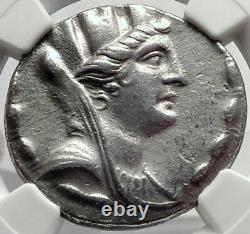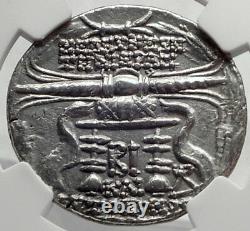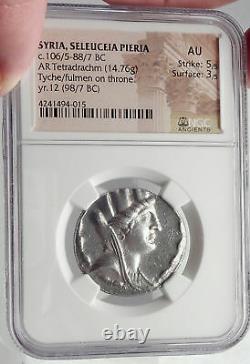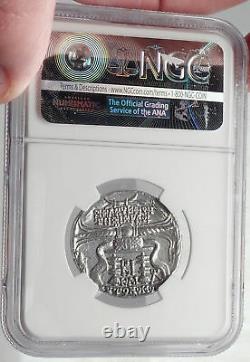
- Index
- Certification
- Composition
- Date
- 138-129 Bc (15)
- 162-150 Bc (3)
- 246-225 Bc (15)
- 281-261 Bc (3)
- 2nd Century Bc (4)
- 305-281 Bc (10)
- 322 Bc (4)
- 336 - 323 Bc (3)
- 336 Bc (4)
- 336-323 B.c. (3)
- 336-323 Bc (24)
- 404 Bc (3)
- 414 Bc (6)
- 440-404 Bc (44)
- 454-404 Bc (12)
- 4th Century Bc (4)
- 95-75 Bc (3)
- Ad 70 (3)
- C. 440-04 Bc (3)
- C. 440-404 Bc (6)
- Other (2678)
- Denomination
- Era
- Year
SELEUKEIA PIERIA 98BC Authentic Ancient Silver Greek TETRADRACHM Coin NGC i64490






Item: i64490 Authentic Ancient Coin of. Silver Tetradrachm 26mm (14.76 grams) Struck City Year (CY) 12, 98/97 B. Reference: HGC 9, 1382 Certification: NGC Ancients. AU Strike: 5/5 Surface: 3/5 4241494-015 Veiled, turreted and draped bust of Tyche right, bead-and-reel border. THS IEPAS-KAI-AYTONOMOY, filleted thunderbolt on throne; BI (date) under throne, ? O monogram in inner right field, all in laurel wreath. Tyche (meaning "luck"; Roman equivalent: Fortuna) was the presiding tutelary deity that governed the fortune and prosperity of a city, its destiny.
She is the daughter of Aphrodite and Zeus or Hermes. In literature, she might be given various genealogies, as a daughter of Hermes and Aphrodite, or considered as one of the Oceanids, daughters of Oceanus and Tethys, or of Zeus. She was connected with Nemesis and Agathos Daimon ("good spirit"). The Greek historian Polybius believed that when no cause can be discovered to events such as floods, droughts, frosts or even in politics, then the cause of these events may be fairly attributed to Tyche.
Increasingly during the Hellenistic period, cities venerated their own specific iconic version of Tyche, wearing a mural crown (a crown like the walls of the city). Tyche had temples at Caesarea Maritima, Antioch, Alexandria and Constantinople. In Alexandria the Tychaeon, the temple of Tyche, was described by Libanius as one of the most magnificent of the entire Hellenistic world. She was uniquely venerated at Itanos in Crete, as Tyche Protogeneia, linked with the Athenian Protogeneia ("firstborn"), daughter of Erechtheus, whose self-sacrifice saved the city. Stylianos Spyridakis concisely expressed Tyche's appeal in a Hellenistic world of arbitrary violence and unmeaning reverses: In the turbulent years of the Epigoni of Alexander, an awareness of the instability of human affairs led people to believe that Tyche, the blind mistress of Fortune, governed mankind with an inconstancy which explained the vicissitudes of the time.
Tyche appears on many coins of the Hellenistic period in the three centuries before the Christian era, especially from cities in the Aegean. Unpredictable turns of fortune drive the complicated plotlines of Hellenistic romances, such as Leucippe and Clitophon or Daphnis and Chloe. She experienced a resurgence in another era of uneasy change, the final days of publicly sanctioned Paganism, between the late-fourth-century emperors Julian and Theodosius I who definitively closed the temples. The effectiveness of her capricious power even achieved respectability in philosophical circles during that generation, though among poets it was a commonplace to revile her for a fickle harlot. The constellation of Virgo is sometimes identified as the heavenly figure of Tyche, as well as other goddesses such as Demeter and Astraea. Later Suedia was a town in antiquity, the capital of Seleucus I Nicator. The city was built, a bit north of the estuary of the river Orontes, between small rivers on the western slopes of the Coryphaeus, one of the southern summits of the Amanus Mountains. The Macedonians called the landscape Pieria, after a district in their homeland that was also between the sea and a mountain range (the Olympus). It functioned as the commercial and naval seaport of the western Seleucid capital of Antioch ad Orontes, present-day Antakya. According to Pausanias and Malalas, there appears to have been a previous city here named Palaeopolis ("Old City"). At present, it is located at the seaside village of Çevlik near the town of Samandag in the Hatay Province of Turkey. Seleucia, Apamea, Laodicea, and Antioch formed the tetrapolis.Seleucia Pieria was founded in ca. 300 BCE by Seleucus I Nicator, one of the successors of the Macedonian conqueror Alexander the Great and the founder of the Seleucid Empire. Seleucia was of great importance in the struggle between the Seleucids and the Ptolemies; it was captured by Ptolemy Euergetes in 246 BCE. As the Ptolemies (Lagids) and Seleucids fought over the city, it changed hands several times until 219 BCE, when the Seleucid Antiochus III the Great recaptured it during the Fourth War (219-217 BCE). Then it obtained its freedom and kept it even to the end of the Roman occupation.
It had long enjoyed the right of coinage. Column plinths of possibly the main/harbour street. When the Seleucid Empire was subdued by the Armenian conqueror Tigranes II, Seleucia Pieria resisted. Roman general Pompey the Great restored the Seleucids to power by giving the city to Antiochus I Theos of Commagene, a direct descendant of Seleucus I Nicator and a loyal ally of Rome. Under light Commagene rule, Seleucia enjoyed substantial autonomy, i.
Seleucia's importance grew significantly over time, necessitating the enlargement of its harbours several times under Diocletian and Constantius. These harbours, called the "inner" and "outer" harbours, served from time to time the Roman navy. Most buildings and structures today date from the Roman period. During Byzantine times the city went into a steady decline. The silting up of the city's harbours hastened this process.In the fifth century CE the fight to keep them open was finally given up. It suffered severely in the devastating 526 Antioch earthquake.
Seleucia was captured by the Sasanids around 540 CE. While it never recovered as a port-city again, Al-Walid ibn Abd al-Malik, Ummayad Caliph from 705-715, built a fortress in the city. The city was Christianized early. As the port of Antioch, "Seleucia on sea"-so called to distinguish it from other cities of the same name-is most notable as the precise point of embarkation from which the Apostle Paul [in 45 CE] and Saint Barnabas sailed from this port on their first missionary journeys, as chronicled in the Bible (Acts 13:4). At the end of that same journey he must have made landfall at Seleucia before going to Antioch (see Acts 14:26).
His route at the beginning of the second journey was by land and probably bypassed Seleucia (see Acts 15:40-41), though on returning, he must have passed through it again (see Acts 18:22). Once more taking a land route when setting out on his third journey, Paul may have missed Seleucia (see Acts 19:1), and at that journey's end he did not return to Antioch and so missed Seleucia again (see Acts 21:7-8). This means that Paul passed through Seleucia at least three times, and probably several more on pre-missionary visits to Antioch (see Acts 11:26; 12:25). The oldest bishop known is Zenobius, present at the Council of Nicaea in 325 CE. Other known bishops include Eusebius, an Arian, and Bizus in the fourth century, with twelve others cited by Le Quien (Oriens Christianus, II, 777-780).
In the sixth century CE the Notitia Episcopatuum of Antioch, gives Seleucia Pieria as an autocephalous archbishopric, suffragan of Antioch (Echos d'Orient, X 144); the diocese existed until the tenth century CE, and its boundaries are known (Echos d'Orient, X, 97). For some Roman Catholic titularies see Eubel, Hierarchia catholica medii aevi, I, 468. A section of the Titus Tunnel. Seleucia Pieria was a diocese of the Orthodox Church in the eighth and ninth centuries CE, three of whose bishops are known. The last-known Orthodox bishop of Seleucia, Ahron (847/874 CE), is mentioned in the lists of Michael.The city is still a titular see of the Roman Catholic Church, Seleuciensis Pierius ; the seat is vacant following the death of the last bishop in 1980. The upper city, about 13 km in circumference, is still distinguishable.
The lower city, smaller than the preceding one, was more thickly populated. Ruins include a necropolis, amphitheatre, citadel, temples, some irrigation works as well as some fortifications. It is believed that it was dug to divert the nearby river and prevent the harbour from silting up with time. A further reason is assumed to be to help reduce flooding caused during heavy winter rains. Construction began during the reign of Emperor Vespasian (69-79 CE) continuing mainly during his son Titus's time (79-81 CE). According to Flavius Josephus, a Roman-Jewish historian 37-ca. 100 CE, Jewish slaves were used as workers. These were working under orders of Emperor Titus, aka Titus Tunnel, who had captured Jerusalem in 70 CE. Other POWs were sent to Rome, where they had to build the Colosseum. According to an inscription, the tunnel/canal was not completely finished until the reign of Antoninus Pius (138-161 CE). The last workers were Roman legionaries.Most parts of the tunnel/canal are intact and it can be visited on foot. Rock tombs are found on the wall of the canal.
Famous residents include Apollophanes, a physician of Antiochus III the Great (third century), and Firmus who aroused Palmyra and Egypt against Rome in 272 CE. World-renowned expert numismatist, enthusiast, author and dealer in authentic ancient Greek, ancient Roman, ancient Byzantine, world coins & more. Ilya Zlobin is an independent individual who has a passion for coin collecting, research and understanding the importance of the historical context and significance all coins and objects represent. Send me a message about this and I can update your invoice should you want this method.Getting your order to you, quickly and securely is a top priority and is taken seriously here. Great care is taken in packaging and mailing every item securely and quickly.
What is a certificate of authenticity and what guarantees do you give that the item is authentic? You will be very happy with what you get with the COA; a professional presentation of the coin, with all of the relevant information and a picture of the coin you saw in the listing. Additionally, the coin is inside it's own protective coin flip (holder), with a 2x2 inch description of the coin matching the individual number on the COA. Whether your goal is to collect or give the item as a gift, coins presented like this could be more prized and valued higher than items that were not given such care and attention to. When should I leave feedback? Please don't leave any negative feedbacks, as it happens sometimes that people rush to leave feedback before letting sufficient time for their order to arrive. The matter of fact is that any issues can be resolved, as reputation is most important to me. My goal is to provide superior products and quality of service. How and where do I learn more about collecting ancient coins? Visit the Guide on How to Use My Store.For on an overview about using my store, with additional information and links to all other parts of my store which may include educational information on topics you are looking for. This item is in the category "Coins & Paper Money\Coins: Ancient\Greek (450 BC-100 AD)". The seller is "highrating_lowprice" and is located in this country: US. This item can be shipped worldwide.
- Certification Number: 4241494-015
- Certification: NGC
- Grade: AU
- Year: Year_in_description
- Composition: Silver
- Denomination: Tetradrachm

